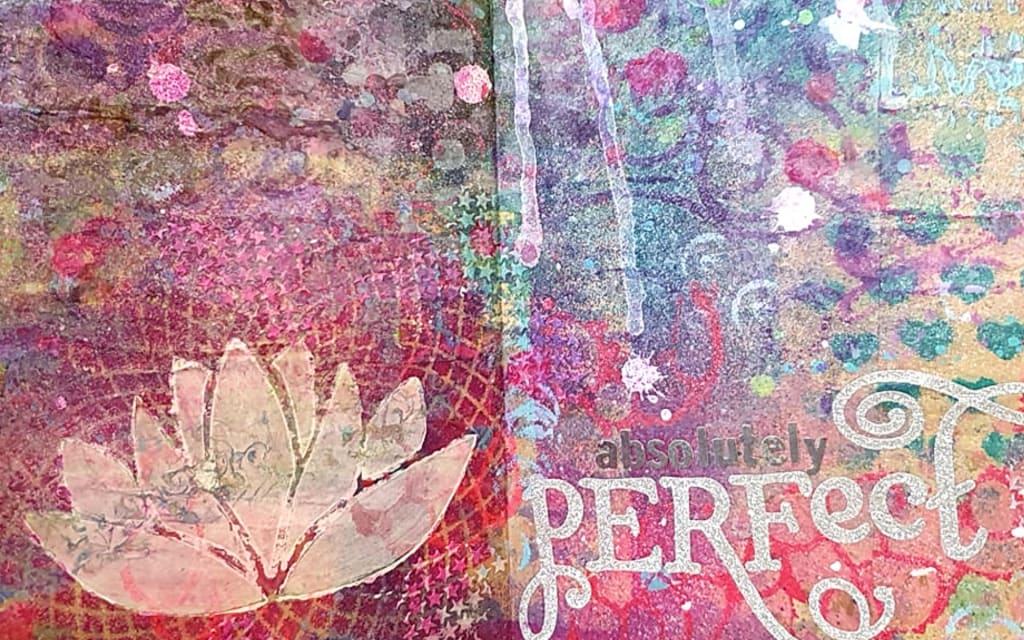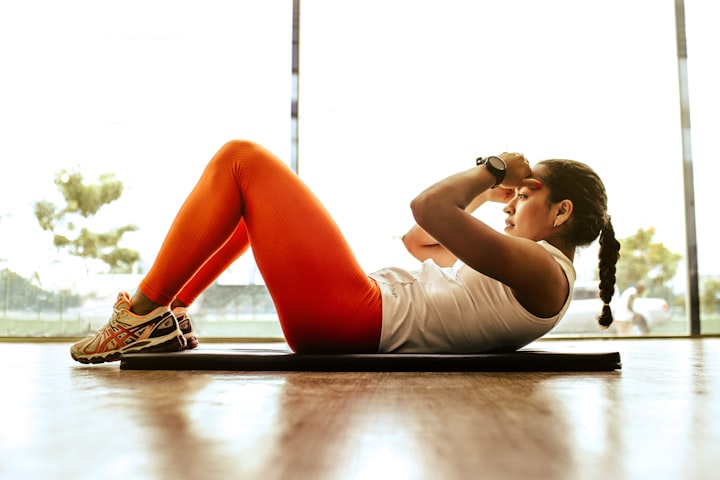
To play along at home, you will need:
- An art journal (this can be a notebook, a sketchbook, or a journal- whatever works best for you)
- Something to write with
- Gesso or white paint
- scissors
- Whatever art supplies you have or want. This can be paint, ink, scrapbooking paper, tissue paper, glitter, magazines and books, crayons, stickers, pastels- whatever you have on hand is perfect, and remember you don’t have to go buy all the expensive stuff for this to work!
Art journaling is a big part of my life, though I tend to take it towards my own, hobbled together version of art therapy. Let’s be honest- right now, life is more complex and overwhelming than usual for a lot of people, and we could all use another way to manage stress, so rather than just telling you the story of why it works for me, lemme tell you what I do, too.
The items I use are important, but probably not for the reasons you might think. Anxiety means that expensive art journals are impossible for me to use. My brain can’t help but do the math, figuring out how much I’ve wasted on an ugly page. But those cheap, terrible ones with the dodgy paper? Bring it on. It’s way less scary to experiment on something you aren’t worried about messing up, so if you’re anything like me, it might be useful to grab yourself a cheap sketchbook (even a lined notebook if that’s all you’ve got right now) rather than the gorgeous watercolour journal you’ve been eyeing. Pro tip, though: notebook paper tends to be really thin, and will crinkle when you add gesso or glue, so if that’s going to bother you, look for something with thicker paper!
Before the art comes the journaling. All the petty, unkind, overwhelmed thoughts that I would never dare say out loud because they’re unfair, and would only cause someone else harm get thrown onto the page. All the horrible things I think about myself on my worst days are scrawled haphazardly there, too. Even that thing that makes you shudder in revulsion at how petty you can truly be- write it all down. That guy who wouldn’t let you get a word in on your date? Rant away, beloved. The person whose entire personality seemed to change the moment you said ‘yes’? Wreck ‘em in language. The charity fundraiser woman who wouldn’t take no for an answer and acted like you were a monster for refusing to give her money? Don’t hold back.
For me, this part is vital. After all, we all have moments of frustration with our loved ones- the misbehaving kids, the flatmate who keeps interrupting your work to tell you about that YouTube video they just saw, the parent whose version of help is overwhelmingly unhelpful- oftentimes, they’re small issues, but when we ignore them, they have the ability to quickly build up into a problem. Especially when there are other things causing you stress.
We’ve all had those moments where something little becomes huge, and the things we could shrug off become impossible to ignore. Taking the time to get all those negative, grumpy thoughts out into the light gives you a chance to see that they’re not a big picture view of a relationship. They’re a snapshot of a moment, and not something you need to hold on to. You get to see what you actually need to address- is this an actual problem, or a sign that you’re overwhelmed and in dire need of a break?
No judgement here, my friend. After all, I’m well aware if I spend too long focused on work and screens, I get grumpy. My ability to tell the difference between an annoyance and an issue runs off to join the circus, and I'm not much fun to be around. That’s why I started this, after all. To ditch all the petty junk clogging up my brain and make space for the good stuff.
The scariest thing about writing like this is the idea of someone stumbling onto it. That thought stopped me journaling so often through my life, especially if I lived with the person or people I was struggling to get along with. All the teen angst. All of it. But this option means I can say whatever I want and not have to worry about it. Because no one but me is ever going to be able to read it.
I love writing in watercolour pencil, but like with the journal itself, anything will do. Sharpies will give you a darker background that does not move- though it may show up on the other side of the page. Graphite, pen or coloured pencil will still shift a little, depending on the type, and are far easier to cover over entirely than permanent marker. But watercolour pencil? It’ll melt, smearing the words and colouring the gesso or paint you’re using, leaving a varied pattern of colour as your base. If you get a little uneasy at the sight of the empty white page, using watercolour pencils to journal with can be a great way to work around that. Which brings up a really important point: this is about you. This is your safe space. There’s no shame in designing it to work around your anxieties or issues, and you can always change the way you approach art journaling to better meet your needs.
Can’t use scissors right now? Tearing paper looks awesome, too, and depending on the type of paper, you can wet a cotton tip and run it along where you want to tear if you want to make a neater line. Can’t stand the idea of paint or ink mess? Grab a glue stick and some magazines and make a collage, or grab some pencils and draw. Don’t have time right now to finish the page, or your hands are shaking too much to create what you want to? Either leave it until later, or add paint or gesso and leave it to dry so you can jump right in later.
This is a shame free zone, and whatever you need to do to feel safe and have fun is perfect.
After you’ve written it all out, there’s an optional step that I find really helpful. I always go back through and read what I’ve just written. Why? Because when I write about the same issue multiple times, my brain inevitably gives suggestions on how to solve the problem. So reading through gives me the chance to take note of any important information or ideas, or save any quotes that I love the phrasing of. I put those quotes and notes in another journal for safe keeping.
Once you’re happy to let go of what you’ve written, you have some choices. Your first choice: do you want this to be grungy and layered, or a flatter surface? That decision sets the tone for the rest of the piece, and impacts what you can do further along in the process. The more layered your pages are, the bulkier your journal will become, and the harder it will be to do detailed things on the pages.
The next choice is how ‘wet’ your page will be. Will you be throwing a bunch of paints and inks at your page, or will you be working with paper and pen instead? If you’re going to use inks and wet media, consider taping up the gap between the two pages with masking tape before you get too far into your project, because it’ll help stop inks leaking through the weaker part of the pages and staining the pages beneath.
For a flatter page, grab some gesso or white paint to cover over the writing. You can also cut up or tear tissue paper to add some additional texture or layers that are thin enough to be almost invisible- I love using either crafting tissue papers or old sewing patterns. If you want a chunkier page, or to really show off some layers, cut up or tear some scrapbooking paper, or add tickets, printed pages, or pages from old books. You can either cover all of the writing, or leave bits visible- there’s no right or wrong here! No matter which option I choose, I love to paint the gesso lightly enough that it protects the page without hiding all of the elements.
If you've never used it, gesso is a page or canvas primer, and in a journal, it will help stop paint or ink leaking onto other pages. Just as important, though, it also means that it evens out the playing field of the page. If you have, say, watercolour pencil, tissue paper, scrapbook paper or tickets on your page, each of those elements is going to react differently to anything you put on top of them. Putting gesso down means that whatever you use next will have the same reaction, no matter where on the page you use it.
Pro tip: if you’re going to use pastels on your page, you’ll need a clear or pastel specific gesso, as it’s more textured and will take the pastels easier. If you’re going to be adding detail with other media, use normal gesso, as it’s less textured.
The next part, frankly, is a free for all. The whole idea is that this doesn’t have to be good. There is no such thing as perfection, and no basic standard of achievement I need to reach for this to be a success. If you've covered the writing up, it's a success already. That whole cheap art journal thing helps here- if it’s ever so ugly I can’t stand to see it, I just glue the pages together and move on. Throw around some paint! Cut out images from magazines and make a collage. Cut words from books and magazines and make a found poem- or take a sharpie to a page and create an erasure poem or message.
There are some great tutorials on YouTube if you find yourself frozen in indecision- I love the old Inspiration Wednesday sessions from Donna Downey, because she has favourite products, but she’s also more than happy to throw anything and everything at her book just to see what happens. If you do go the tutorial route, it’s important to remember that a lot of artists tend to gravitate towards the more expensive paints and inks- which is great if you can afford them, but they’re not mandatory, or even necessary. Grab your kid’s unused paint pan set, or crayons, or whatever is on hand, and give yourself permission to have fun.
I have a lot of supplies, and tend to love layers, so I’ll stencil onto the page with texture paste to make layers, or create washes, or draw pictures. I love to add quotes, too- I spend way too long on Pinterest looking for inspiration, if I’m being honest. Some of my pages have a lot going on, others have almost nothing- you can do as much, or as little, as you want.
The picture I've included, clearly, has a lot going on. The entire journaling session was covered with kraft paper. I'd been laying kraft paper down to protect the table when I was painting or working with ink, and it was getting covered with drips and fans of ink spray that I figured I'd use in my journal. I was even leaving my used stencils on there as I worked, which added patterns, too- in fact, a lot of the coloured 'design elements' in the background are random mess from other projects! I used inks to spray stencil designs onto the paper before stenciling in the lotus and the little stars with texture paste. The writing is stickers from my scrapbooking stash.
I love this part of the process, because you’re physically making something new out of all those ugly thoughts and unwanted feelings. It’s an act of magic, taking something you’re unhappy with and giving it the chance to be something more. Also? Working with your hands helps you get out of your head a little more, distancing yourself from those thoughts and feelings so they don’t have quite so much power over you.
Sometimes, I’ll make something beautiful. Sometimes, not so much. And that doesn’t matter in the slightest, because I always feel better at the end of the process, even if I’m not sure anyone has ever managed to create something uglier than the finished page I’m looking at. It doesn’t have to be pretty, or perfect, or even something happy. The finished product is way less important than the act of getting the negative thoughts out of your head, and actively making time for fun.
There are probably millions of ways you can play with this idea. In the past I’ve laid lines of masking tape onto baking paper and written on the tape with Sharpies. Spray some pretty coloured inks onto the tape and let it dry and presto, decorative tape nobody can read or have the context for. I’ve ranted on notebook paper, torn it up and stuck it onto a journal page. I’ve burned ranty notebook pages and mixed the ash with paint. The only limit is your imagination, and you, my dear, have the ability to make absolute magic here.
Good luck!
About the Creator
Kylie T
Poet, storyteller, and purveyor of vaguely concerning true crime facts.






Comments
There are no comments for this story
Be the first to respond and start the conversation.